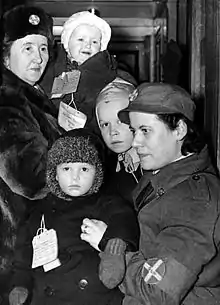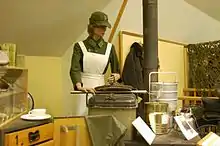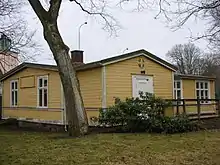Swedish Women's Voluntary Defence Organization
The Swedish Women's Voluntary Defence Organization[lower-alpha 1] (Swedish: Riksförbundet Sveriges lottakårer (juridical), communicatively known as Svenska Lottakåren, SLK[3] lit. 'The Swedish Lotta Corps') is an independent auxiliary defence organization in Sweden. The organisation is part of the Swedish Total Defence (Totalförsvaret), the national defence strategy of Sweden.
| Swedish Women's Voluntary Defence Organization | |
|---|---|
 Swedish Women's Voluntary Defence Organization with Finnish war children during World War II. | |
| Founded | 1924 |
| Country | |
| Size | 5,000 |
| Garrison/HQ | Stockholm |
The organisation was created in 1924 as a Swedish version of the Finnish equivalent organisation Lotta Svärd (created in 1918), which subsequently inspired other Scandinavian and the Baltic states to create their own organisations based on the same principles. These are collectively called "Lotta movements" as the majority of these organisations have adopted the name Lotta as the general designation for organisation members.[4][5][6][7]
Organisation
The organization currently consists of approximately 5,000 women of all ages throughout Sweden. Svenska Lottakåren's purpose is to recruit and educate women for tasks in the Swedish total defence, and to conduct comprehensive defence training. Svenska Lottakåren works in both the Armed Forces and in Civilian Emergency Preparedness. The organization is politically neutral, and is one of the country's largest female networks.
Members are called lotta (singular) or lottor (plural).
History

Origin
Svenska Lottakåren was created in 1924 with the Finnish women's auxiliary organization, Lotta Svärd (founded in 1920), as a direct role model. The name Lotta comes from a poem by Johan Ludvig Runeberg, about a fictional woman named Lotta Svärd, who took care of wounded soldiers during the Finnish War.
The organisation was founded by a Swedish woman named Tyra Wadner, whom also became the organization's first chairman, and was originally an auxiliary aid unit for the Swedish Landstorm militia, then named Sveriges Landstormskvinnor (Sweden's Landstorm Women).
The organisation's original mission was none militant and primarily aimed at collecting money for the Landstorm militia. However it quickly became apparent that the organisation was needed for militant missions during wartime, however of none combatant nature. In 1936 rules were laid down that regulated the organisation's activities in peacetime and wartime. In peacetime, the activities would be concentrated in four areas:
- Collection of funds for the Landstorm militia
- Provide service at Landstorm militia exercises
- Training of their own members
- Information work to "raise the motherland and homeland patriotism feeling and strengthen the nation's defence".
During the war, Svenska Lottakåren instead had to undertake various forms of assistance for defence in the homeland, especially during mobilization.[8] Members were divided into army, navy and airfields.
World War II
During World War II, the organization received many new duties. Due to limited manpower it was decided to let organisation members perform service duties of none combat nature in Sweden's army, navy and air force branches. It was during this period that members of the organisation started being called lottor, as their original name "Landstormskvinnor" did not fit their new roles. This soon became official as the Swedish Landstorm militia was scrapped and replaced with the Swedish home guard in 1942, turning the organisation independent. The new organisation name became Riksförbundet Sveriges lottakårer ("The national federation of Sweden's Lotta corps").[9]
The war also rapidly increased the number of organisation members and by the end of the war the organization had more than 110,000 members, which meant that about five percent of Sweden's women over 15 years were part of the organisation.[10]
Post 1989
In 1989 the Swedish military started allowing women into all positions within the Swedish armed forces. This meant that the Swedish Women's Voluntary Defence Organization was no longer the only true option for women to get an active role in the defence of Sweden. An equivalent change in Denmark the same year had lead to the dissolution of their "Lotta movement" Lottekorps.[7] However in Sweden the organisation would remain as they still held important roles in the Swedish defence, as well as their cultural value.
In 2008 the organisation updated their graphical profile and changed their communicative name into Svenska Lottakåren ("The Swedish Lotta Corps").[3] The old name "Riksförbundet Sveriges lottakårer" was however kept as the official juridical name.[3]
Awards and decorations
Members and non-members of the Swedish Women's Voluntary Defence Organization which have benefited the organization can be awarded different awards and decorations, for example the Swedish Women's Voluntary Defence Organization Royal Medal of Merit in gold and silver (awarded since 1943) and the Swedish Women's Voluntary Defence Organization Medal of Merit in gold (awarded since 1967) and silver (awarded since 1944).[11]
Heads
- 1924–1931: Tyra Wadner
- 1931–1945: Maja Schmidt
- 1945–1959: Märta Stenbeck
- 1959–1966: Ingrid Norlander
- 1966–1974: Louise Ulfhielm
- 1974–1978: Alice Trolle-Wachtmeister
- 1978–1986: Christine Malmström Barke
- 1986–1994: Marianne af Malmborg
- 1994–2002: Nini Engstrand
- 2002–2008: Elisabeth Falkemo
- 2008–2014: Annette Rihagen
- 2014–2018: Barbro Isaksson
- 2018–present: Heléne Rådemar
Other Lotta movements
 Finland: Lotta Svärd (1918-1944)[lower-alpha 2]
Finland: Lotta Svärd (1918-1944)[lower-alpha 2] Estonia: Naiskodukaitse "NKK" (1925-onward)[4][5]
Estonia: Naiskodukaitse "NKK" (1925-onward)[4][5] Norway: Norges Lotteforbund "NFL" (1928-onward)[6]
Norway: Norges Lotteforbund "NFL" (1928-onward)[6] Denmark: Lottekorps (1946-1989)[7]
Denmark: Lottekorps (1946-1989)[7]
Footnotes
- Official name according to their own website.[1] Also translated as the National Federation of Swedish Women’s Auxiliary Defence.[2]
- See the article Lotta Svärd.
References
Notes
- "Svenska Lottakåren in English". Swedish Women's Voluntary Defence Organization. Retrieved 4 June 2020.
- Gullberg 1977, p. 741
- Grafisk identitet 2008, p. 1
- "PDF about Estonia's Lotta movement history" (PDF). naiskodukaitse.ee. Retrieved 2021-01-05.
- "Taasloomine". naiskodukaitse.ee. Retrieved 2021-01-05.
- "NORGES LOTTEFORBUND". lottene.no. Retrieved 2021-01-05.
- "FOV Nyhedsbrev nr.12, 2001". fov.dk. 2001. Archived from the original on 2007-07-16. Retrieved 2021-01-05.
- Sundevall 2011, pp. 53-54
- "Riksförbundet Sveriges lottakårer (SLK)'s archive". sok.riksarkivet.se. Retrieved 2021-01-05.
- Sundevall 2011, p. 58
- Bestämmelser 2019, pp. 1-5
Print
- Gullberg, Ingvar E. (1977). Svensk-engelsk fackordbok för näringsliv, förvaltning, undervisning och forskning [A Swedish-English dictionary of technical terms used in business, industry, administration, education and research] (in Swedish) (2nd ed.). Stockholm: Norstedt. ISBN 91-1-775052-0. SELIBR 8345587.
- Sundevall, Fia (2011). Det sista manliga yrkesmonopolet: genus och militärt arbete i Sverige 1865-1989 [The last male occupational monopoly: gender and military work in Sweden 1865-1989] (in Swedish). Stockholm: Makadam. ISBN 9789170610905. SELIBR 12071314.
Web
- "BESTÄMMELSER FÖR SVENSKA LOTTAKÅRENS UTMÄRKELSETECKEN OCH ÅRSNÅLAR" (PDF) (in Swedish). Swedish Women's Voluntary Defence Organization. 2019-01-09. Retrieved 28 January 2021.
- "Svenska Lottakåren: Grafisk identitet" (PDF) (in Swedish). Swedish Women's Voluntary Defence Organization. 2008. p. 1. Retrieved 29 January 2021.

